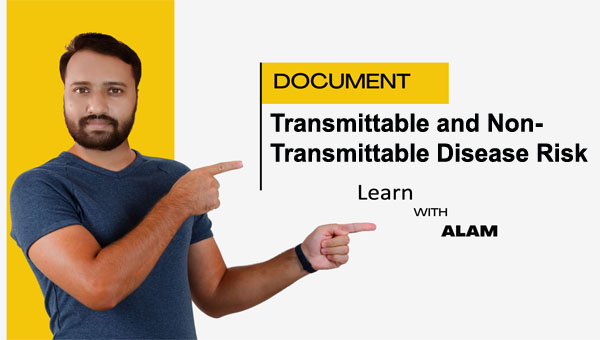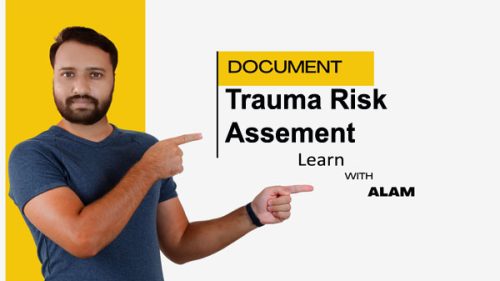
Transmittable and Non-Transmittable Disease Risk Assessment: Steps, Tools, and Prevention Strategies
Original price was: 100.00৳ .29.00৳ Current price is: 29.00৳ .
Transmittable and Non-Transmittable Disease Risk Assessment: Steps, Tools, and Prevention Strategies
Introduction
Understanding the risks associated with Transmittable and Non-Transmittable Diseases is crucial for both public health officials and individuals. Proper disease risk assessment helps identify potential hazards, prevent outbreaks, and manage chronic conditions effectively. In this guide, we’ll explore how to conduct risk assessments for both types of diseases, the tools used, and prevention strategies to stay healthy.
What Is Disease Risk Assessment?
Disease risk assessment is the process of identifying, evaluating, and mitigating risks related to diseases. This involves understanding how diseases spread, the likelihood of infection or health complications, and strategies to reduce exposure and impact. Transmittable and Non-Transmittable Disease Risk.
Transmittable Disease Risk Assessment
What Are Transmittable Diseases?
Transmittable diseases, also known as infectious diseases, are caused by pathogens like bacteria, viruses, fungi, and parasites. They can spread from person to person, animals, or the environment. Transmittable and Non-Transmittable Disease Risk.
Key Steps in Transmittable Disease Risk Assessment
- Identify Pathogens and Transmission Routes
- Determine if the disease spreads via air, direct contact, bodily fluids, or contaminated surfaces.
- Example: COVID-19 spreads through respiratory droplets.
- Assess Exposure Risks
- Identify high-risk groups (e.g., healthcare workers, immunocompromised individuals).
- Consider environmental factors like crowded spaces or poor sanitation.
- Evaluate Severity and Likelihood
- Consider factors like disease mortality rate, contagiousness, and treatment availability.
- Example: Tuberculosis is highly contagious but manageable with early treatment.
- Implement Control Measures
- Personal Protective Equipment (PPE): Masks, gloves, and hand hygiene.
- Vaccinations: Immunization programs to prevent diseases like influenza and measles.
- Quarantine and Isolation: Prevent the spread during outbreaks.
Tools for Transmittable Disease Risk Assessment
- Infection Control Checklists
- Pathogen Surveillance Systems
- Contact Tracing Software
Keywords: “transmittable disease risk assessment,” “infection control,” “disease prevention strategies.”
Non-Transmittable Disease Risk Assessment
What Are Non-Transmittable Diseases?
Non-transmittable diseases, also known as non-infectious diseases, are not caused by pathogens and cannot be spread from person to person. They are often influenced by lifestyle, genetics, or environmental factors.
Examples of Non-Transmittable Diseases
- Diabetes
- Cardiovascular Diseases (Heart Disease, Stroke)
- Cancer
- Chronic Respiratory Diseases (COPD, Asthma)
Key Steps in Non-Transmittable Disease Risk Assessment
- Identify Risk Factors
- Lifestyle: Poor diet, lack of exercise, smoking, alcohol use.
- Genetics: Family history of diseases like diabetes or heart disease.
- Environment: Exposure to pollution or hazardous substances.
- Assess Personal and Population-Level Risk
- Use screening tools (e.g., blood pressure tests, cholesterol checks).
- Conduct surveys to determine lifestyle habits in populations.
- Evaluate Impact and Likelihood
- Consider disease prevalence, severity, and potential complications.
- Example: Obesity increases the likelihood of developing type 2 diabetes.
- Develop Prevention and Management Strategies
- Healthy Lifestyle Programs: Promote balanced diets, regular exercise, and smoking cessation.
- Regular Screenings: Early detection of diseases like cancer through mammograms or colonoscopies.
- Education Campaigns: Raise awareness about risk factors and prevention.
Tools for Non-Transmittable Disease Risk Assessment
- Health Risk Assessment Surveys
- Body Mass Index (BMI) Calculators
- Chronic Disease Registries
Transmittable and Non-Transmittable Disease Risk assesment.
Keywords: “non-transmittable disease risk assessment,” “chronic disease prevention,” “lifestyle risk factors.”
Comparing Transmittable and Non-Transmittable Diseases Risk Assessment
| Aspect | Transmittable Diseases | Non-Transmittable Diseases |
|---|---|---|
| Cause | Pathogens (bacteria, viruses, etc.) | Lifestyle, genetics, environment |
| Spread | Person-to-person, animals, surfaces | Not contagious |
| Control Measures | Quarantine, PPE, vaccines | Healthy lifestyle, regular screenings |
| Examples | COVID-19, Influenza, Tuberculosis | Diabetes, Cancer, Heart Disease |
Conclusion
Transmittable and Non-Transmittable Diseases risk assesement is essential for preventing illness, managing health risks, and improving public well-being. By understanding transmission routes, risk factors, and prevention strategies, individuals and healthcare systems can take proactive steps to mitigate these risks effectively.Transmittable and Non-Transmittable Disease Risk assesment.
Regular screenings, proper hygiene, vaccinations, and healthy lifestyle choices are key components of an effective disease prevention plan.
FAQs
1. What is the difference between transmittable and non-transmittable diseases?
Transmittable diseases are contagious and caused by pathogens, while non-transmittable diseases are non-infectious and influenced by genetics or lifestyle factors.
2. How can transmittable diseases be prevented?
By practicing good hygiene, getting vaccinated, wearing PPE, and isolating infected individuals.
3. What are the main risk factors for non-transmittable diseases?
Lifestyle choices (e.g., poor diet, smoking), genetics, and environmental factors.
Only logged in customers who have purchased this product may leave a review.






Reviews
There are no reviews yet.